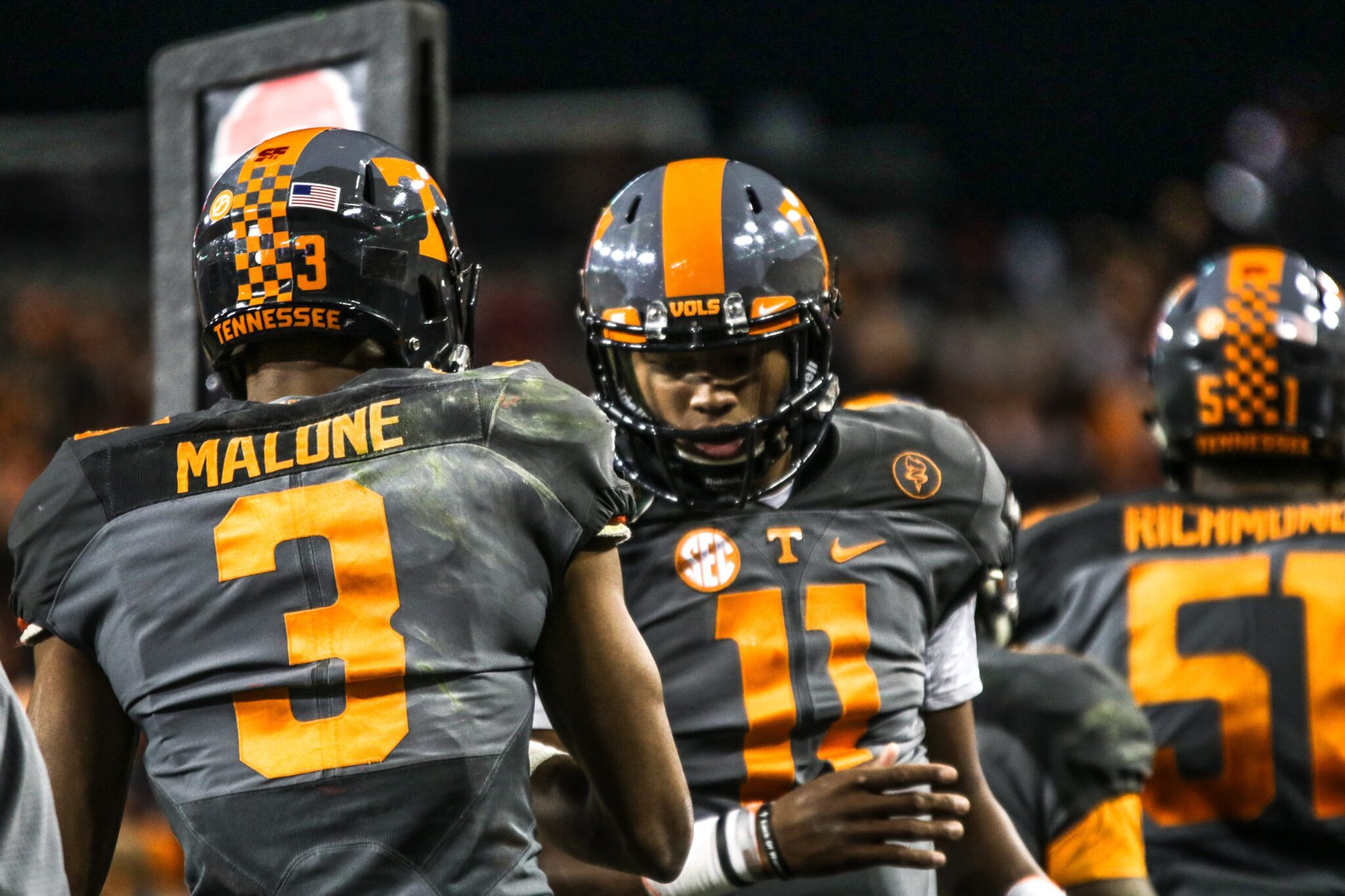The 2017 NFL Draft All-Underappreciated Team
There’s a boatload of talent in this year’s draft class. Make sure not to sleep on these guys.

Tennessee wide receiver #3 Josh Malone and quarterback #11 Joshua Dobbs celebrate following a long touchdown during the Vols' 38-24 win over Nebraska at the 2016 Franklin American Mortgage Music City Bowl on Dec. 30 in Nashville, Tennessee.
In a draft class that features plenty of depth, several prospects fly under the radar throughout the draft process.
Here’s the 2017 NFL Draft’s All-Underappreciated Team.
QB: Joshua Dobbs (Tennessee)
I know, I know, a Tennessee prospect to start off this article?
“Bias!!!”
Just hear me out. The takes for Josh Dobbs throughout the draft process ranges from “The next Dak?” to “This guy is undraftable!” Oh, and apparently Todd Mcshay would rather spend a second round pick on Dobbs than a first rounder on any of the top four guys. I may not take it that far, but OK, I hear you Todd!
The former Vol is one of like five quarterbacks from this class who have been classified as this year’s Dak Prescott, so that comparison should be taken rather lightly. Yet, the skeptics have fumed from the mouth over the hype for Dobbs brought on by a handful of experts and has led to hate that reaches unwarranted levels. Let’s be real, expecting Dobbs to be the next Prescott is ridiculous, but his skillset is deserving of at least a role as a solid backup quarterback/bottom tier to potentially average starter in the NFL. Certainly there will be teams who fall in love with the intangibles and athleticism that comes with Dobbs.
Despite a rough senior season when it comes to his decision making (12 INTs in 2016, 11 combined in 2014-2015), Dobbs was a more accurate passer than given credit for. He completed 225 passes at a 63 percent rate while also tallying 40 total touchdowns and nearly 3,800 total yards. You can look at games such as the victory over Florida and the traits are there to provide intrigue. As for games such as South Carolina, the weaknesses were on full display. Yet, the strengths that Dobbs brings to the table are unmatched by the remaining prospects in the second tier of quarterbacks. Teams will see that, and they observed it with their own eyes during Dobb’s impressive Senior Bowl week and Senior Day performances. Especially given the underwhelming 2017 quarterback class as a whole, Dobbs has a case for the best prospect following the four guys in the top tier, and I’m willing to bet there are a handful of a NFL teams that agree. Again, there are weakness that come with his game which makes some of the criticism warranted. Yet, his seem to get scrutinized more than the other quarterback prospects in the second tier for whatever reason which is ultimately why he made this list. After the top four quarterbacks, Josh Dobbs may be my fifth favorite quarterback in this class. Part of that is due to the lack of quarterback talent, part of that is credited to his intriguing skillset. Nathan Peterman, Davis Webb or Brad Kaaya over Dobbs? No thanks. Call me crazy, but I’d take a third or fourth round flyer on the former Vol if I’m a team looking to add a quarterback at that point in the draft. Apologies for spending the most time on the Tennessee guy, but this one needed the most justification.
HB: Marlon Mack (South Florida)
Measuring in at 5-foot-11 and weighting around 213 pounds, Marlon Mack’s size and skill set resembles that of a scat back. His combine numbers aren’t eye-popping by any means, but Mack’s athleticism translates on the field when it comes to his fluid running style and excellent body control.
Mack’s most intriguing quality is the big play threat he brings. Averaging 6.7 yards per carry over the last two years, six of his fifteen touchdowns in 2016 went for at least 40 yards. His abilities as a receiver (28 catches for 227 yards in 2016) adds to his value on an NFL roster and will be a great option to use on third-down situations.
While this running back class is not nearly as loaded as it was once perceived to be, there will be tons of value to be had in the middle rounds. Marlon Mack’s name doesn’t come up nearly enough when it comes to discussing the backs in this class, but his skill set and big-play ability will earn him a valuable role in today’s NFL.
WR: Ryan Switzer (North Carolina)
At 5-foot-8, Switzer ranks in the bottom 10 percentile for both height and weight among wide receivers in this draft class. Plus, his skill set limits him to a slot receiver/punt returner in the NFL.
These factors have most believing he’ll drop in the draft and causes several to overlook the production and intrigue that comes with Switzer as a prospect. It should be noted his seven career punt-return touchdowns ranks first in ACC history, which combined with his ability as a receiver makes him potentially even more valuable as a prospect.
Since 2013, his 17 plays of 60-plus yards ranks first by a significant margin (Stanford’s Christian McCaffrey was second with nine). During his career at North Carolina, he caught 97 of his 129 targets, good for a ridiculous 75 percent catch rate. His quickness and elusiveness creates a matchup nightmare for opposing defenders and his hands are more reliable than given credit for. Wide receiver guru Matt Harmon compared Switzer to Washington Redskins wide receiver Jamison Crowder. Considering the size and skill sets of each, this comparison is spot on.
Given the NFL’s continuous trend to a more pass happy league, Switzer’s role has more than enough value worthy of a pick in the first two day rather than a day three selection.
TE: Jordan Leggett (Clemson)
The tight end class put together a dominant display at the combine, causing a number of prospects to gain in popularity. Unfortunately, Leggett was not included in the tight ends who destroyed the athletic tests and has caused his name to fall under the radar. With that being said, Leggett is a fine athlete and at 6-foot-5 and 258 pounds, has the size and speed to compete at a high level in the NFL.
When considering his skill set, Leggett is going to make a team very happy in one of the middle rounds. As a receiver, Leggett has shown the ability to play in the slot or in-line, and that versatility makes him valuable at the next level and many experts have labeled him as a “seam-buster”. In addition, he’s one of the most sure-handed tight ends in the class.
While at Clemson, Leggett showcased a knack for showing up in critical moments during crucial games, which was highlighted by his performances in the National Championship (he combined for 12 catches, 173 yards and a touchdown). He also tacked in a five-catch, 122-yard performance in a 37-34 road victory over Florida State this past season.
But Leggett isn’t simply a pass catcher. Contrary to popular belief, Leggett’s ability to block is attention-grabbing, as he impressed against the likes of Jonathan Allen, Tim Williams and Ryan Anderson. This part of his game is typically viewed as his weakness, but he’s proven the ability to handle premier college defenders in one-on-one situations.
Overall, Leggett is an ideal No. 2 tight end for several NFL teams. He isn’t a freak athlete like O.J. Howard, but he’s one of the safer bets at the position.
OL: Julie’n Davenport (Bucknell)
As a whole, offensive line is one of the draft’s more underwhelming positions. There are some solid guys at the top, but there is very little depth in the class. For those teams who elect not to take an offensive lineman in the first 2-3 rounds, there are minimal options worthy of selections beyond that point, but due to the importance of the position, there will be several taken on the third day that will surely be out of the league pretty quickly.
With that being said, Julie’n Davenport is one of the few worth considering as a Day 3 developmental/rotational offensive tackle. Due to his size, length and athleticism, Davenport will surely be highly coveted come Day 3 and could be off the board quickly come that point. Though a bit raw, it’s understandable why NFL scouts would fall in love with Davenport’s potential, considering he’s a 6-foot-7, 318-pound specimen with an arm length of 36.5 inches
The skeptics will point to a lack of competition, but Davenport was named to the All-Conference First-Team three years in a row. The two-time captain will need at least a year of development before handling NFL pass rushers. Yet, the mediocre offensive line class makes him worth a gamble in a later round. The same can’t be said for most of the offensive lineman beyond the top tier. Ultimately, he could surprise and sneak his way into the Top 100.
DL: Dalvin Tomlinson (Alabama)
The talent level on Alabama’s defense this past season was ridiculous, which caused Tomlinson’s excellent season to go overlooked by most. It must be noted that Tomlinson is one the strongest defenders against the run. Seriously, he dominates in the run game. Combine that with the lack of depth at the interior defensive line position in this draft class, Tomlinson will surely go higher than most expect.
Don’t be surprised if he makes his way into the top 50, especially given the number of teams seeking a run stuffer to plug in the middle of their defensive line. The critics will point to his lack of production as a pass rusher and those people will also argue this limits Tomlinson to a two-down role in the NFL, but I disagree. According to Pro Football Focus, Tomlinson notched 43 quarterback pressures in 2016, definitely his most promising season as a pass rusher. If Tomlinson can continue to improve in this area of his game and ultimately cause more disruption with his hurries, he’ll be an instant contributor for an NFL team. If not, he can still be extremely effective in the run game. Given the demand for his position combined with the limited supply in this draft class, Tomlinson will be a desired commodity come draft day
EDGE: Jordan Willis (Kansas State)
After putting on one of the most impressive combine performances, Willis’ stock skyrocketed. Yet, many draft experts still don’t seem high enough on him as they should. While some label him as a first-round lock, others view him as a project and better suited as a second round pick. Personally, Willis is deserving of a Top 20 pick and ultimately will be a first round lock. Even in a scheme at Kansas State that limited his ability to use his athleticism, he still finished second in the country last season in total pressures (80) according to Pro Football Focus.
After posting elite times in the 40-yard dash, three cone and broad jump, Willis won’t be on the board for very long. One of my favorite defensive lineman evaluators, Charles McDonald, noted the similarities between Willis and current Minnesota Viking Danielle Hunter. Hunter is another athletic freak and just finished up a 12.5 sack season in his second year as a pro. Yet, the scheme ran by LSU during his college days limited his production and caused Hunter to slip all the way to the third round. Unlike Hunter, Willis has the college production to back up his elite athletic ability and both of these factors make him one of the best pass rushing prospects in the class, and one worthy of a pick in the first round.
HOT TAKE: Jordan Willis will finish with more sacks than Myles Garrett by the end of their careers.
LB: Tanner Vallejo (Boise State)
After a dominant 2014 sophomore season, injuries derailed the remainder of Vallejo’s college career. In addition, his lack of size and length serve as a weakness when evaluating him at the next level plus he’s been susceptible to missing tackles over the past two season. Granted, the tackling issues from this past season could be partly due to a broken wrist he elected to play through for most of the season.
Despite the concerns, Vallejo has proven to be effective against both the pass and run. His athleticism and instincts make him a viable Day 3 option. Depending on a team’s scheme, he can fill in as a 4-3 will linebacker or an inside linebacker in a 3-4 scheme. Given the lack of depth at the linebacker position, there will be several teams interested in Vallejo in one of the later round and could prove to be a steal if he can return to his 2014 form. It’s been reported that teams such as the Bills and Falcons are high on the former Bronco linebacker. There are certainly aspects of his game that need some cleaning up, but the athleticism and instincts ensure the idea of him fitting the script for what NFL teams seek in a linebacker.
CB: Cordrea Tankersley (Clemson)
The ridiculous depth at the corner positions has created tons of buzz over the draft process. The amount of players worthy of a Top 100 pick could lead to a record setting number of corners selected in the first two rounds. Due to the high number of talented corners, some names have failed to generate the buzz they deserve. More than most, Condrea Tankersley fits as a victim in this respect.
According to Pro Football Focus, Tankersley held opposing quarterbacks to a 41.2 passer ratings over the past two season. That’s absurd. When it comes to how he projects at the NFL, he possess the size and length (6-foot-1 with an arm length of 32 ¼ ) that fits the mold for a prototypical NFL outside corner. He’s a perfect fit for teams who prefer man coverage schemes, as he excelled in this aspect during his college career while also possessing the traits to perform well in zone schemes. This sense of versatility will have several potential suitors interested regardless of scheme. While many experts tend to have him outside of their top five corners, there’s a reasonable chance Tankersley ends up becoming a top three corner from this class.
S: Eddie Jackson (Alabama)
A season-ending injury in 2016 sure did some damage to Eddie Jackson’s draft buzz. Yet, the corner turned free safety displays the skill set made for a “center fielder” type free safety. According to Pro Football Focus, Jackson allowed less than half of passes thrown in his direction to be completed and opposing quarterback possessed a quarterback rating just under 50 when targeting him. With elite ball skills and play-making ability, Jackson has the potential to be a legit difference maker in a NFL team’s secondary. Plus, his experience as a cornerback adds value when it comes to his ability to play in man coverage. Though poor defending the run, players with Jackson’s skill set don’t come around very often. Given he fully recovers from the fractured leg, Jackson could turn out to be quite a steal for a team in the third or fourth round.
Edited by David Bradford
Featured image by Ben Proffitt



